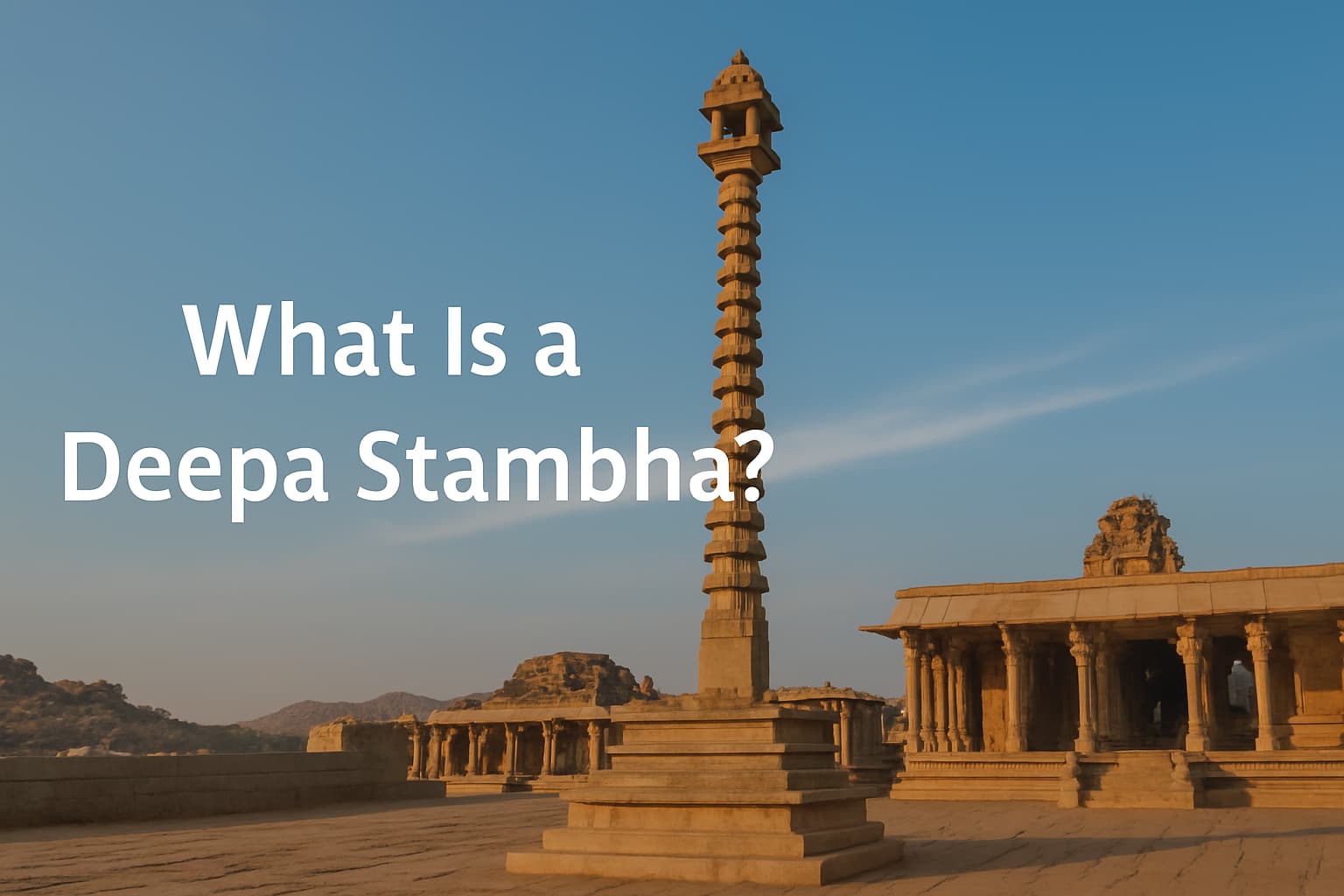Deepa Stambha meaning goes beyond its literal translation — it represents the spiritual essence of light guiding devotees toward the divine. In many traditional Hindu temples, especially across South India, you’ll find a tall, beautifully carved stone or metal pillar standing near the entrance, adorned with small holders for oil lamps that rise in a vertical line. This striking structure is the Deepa Stambha — the “pillar of light” — a silent yet radiant symbol of awakening, purity, and divine energy. But why is it placed outside temples? What does it truly signify in temple traditions? And why is it ritually lit during festivals and sacred events? Let’s uncover the light behind this ancient symbol and its enduring place in Hindu temple architecture.
🪔 What Is a Deepa Stambha?
Deepa Stambha meaning is derived from Sanskrit, where Deepa means lamp or light and Stambha means pillar. Together, they form “pillar of light” — a sacred vertical column placed at the entrance of many Hindu temples.
A Deepa Stambha is usually made of stone or metal and features built-in niches designed to hold oil lamps (deepas). These are lit during festivals like Deepavali, Karthika Deepa, and during major temple processions. The structure is both architectural and spiritual — a glowing symbol of welcome and worship.
These pillars vary in size, with most ranging from 8 to 20 feet tall, though some in historic temples can reach 30 feet or more. One of the most iconic examples is the Banashankari Temple in Karnataka, where the Deepa Stambha stands tall and radiant during the annual ಜಾತ್ರೆ (jatre or temple fair), drawing thousands of devotees.
🔍 Where Are Deepa Stambhas Found?
The Deepa Stambha meaning comes to life in many iconic temples across India, especially in South and coastal regions. Below are some temples where Deepa Stambhas are not only architectural elements but also actively used in rituals and festivals.
| Temple Name | Location | Deepa Stambha Highlights |
|---|---|---|
| Banashankari Amma Temple | Badami, Karnataka | Massive stone Deepa Stambha lit during the annual ಜಾತ್ರೆ (Jatre); symbolic of local devotion and protection |
| Shri Mahalakshmi Temple | Kolhapur, Maharashtra | Metal Deepa Stambha used during Navaratri; pillar reflects devotion to Shakti tradition |
| Sri Mookambika Temple | Kollur, Karnataka | Multi-tiered pillar lit during Karthika Deepa and Rathotsava; placed near entrance mandapa |
| Mahadev Tambdi Surla Temple | Sanguem, Goa | Ancient 12th-century Deepa Stambha in front of unique Kadamba-style shrine |
| Ramaswamy Temple | Kumbakonam, Tamil Nadu | Tall granite Deepa Stambha lit during Rama Navami; classic example of Tamil temple architecture |
| Udupi Sri Krishna Matha | Udupi, Karnataka | Stone Deepa Stambha at the entrance, often decorated during Karthika Masa and Paryaya festival |
🪔 Note: Deepa Stambhas vary in size and form — from simple single-tier pillars to towering multi-tier spirals. Their presence reinforces light as a core element of temple tradition.

✨ Spiritual Symbolism of Deepa Stambha
The Deepa Stambha meaning goes far beyond structure or aesthetics — it is deeply rooted in symbolism that touches the heart of Hindu philosophy. This sacred lamp pillar, standing tall outside the temple, silently conveys timeless truths.
🔹 1. Victory of Light Over Darkness
Lighting the Deepa Stambha symbolizes the triumph of knowledge over ignorance. As each flame rises, it reflects the devotee’s inner journey from confusion to clarity — from darkness to divine wisdom.
🔹 2. Awakening the Divine Presence
In Hindu belief, light is life itself. Lighting a Deepa Stambha is more than a ritual — it is an act of awakening the presence of the deity. Every lamp lit is like calling out to Devi or Deva with pure devotion.
🔹 3. Guiding Devotees to the Temple
In earlier times, especially in villages and forest regions, the stambha served as a beacon. When lit in the early morning or late evening, it guided devotees to the temple, just like a spiritual lighthouse.
🔹 4. Symbol of Vertical Ascent
The upward arrangement of flames on the stambha is not random — it represents the soul’s elevation from earthly attachment to higher consciousness. It’s a reminder that devotion should rise, not remain stagnant.
🕯 When and Why Is the Deepa Stambha Lit?
The Deepa Stambha is not lit randomly — each occasion carries spiritual and cultural meaning. Lighting it is an act of reverence, a ritual that invites divine energy into the temple space.
🔸 During Daily Evening Poojas (Sandhya Deepa)
As day turns to dusk, temples light the Deepa Stambha to honor the transition — a sacred moment symbolizing inner awakening.
The flames also ward off negative energy and prepare the temple for nighttime silence and sanctity.
🔸 Throughout Karthika Masa (Especially Mondays)
The month of Karthika (October–November) is considered highly auspicious for lighting lamps.
Devotees offer ghee or oil lamps to the stambha every Monday, praying for spiritual purity and family well-being.
🔸 On Festival Days (Deepavali, Navaratri, Rathotsava)
Deepa Stambhas are brightly illuminated during major festivals like:
Deepavali – symbolizing the victory of light
Navaratri – especially at Shakti temples
Rathotsavas – temple car festivals, where the stambha marks the sacred path
🔸 Before Important Temple Events or Homas
Before yajnas, special poojas, or homas, lighting the Deepa Stambha is seen as invoking Agni (fire god) and clearing the path for sacred energies to flow.
🕯️ How Is the Deepa Stambha Lit?
Lighting the Deepa Stambha is often a shared act of devotion. In many temples, you’ll see devotees gently placing oil lamps into the small holders, lighting them one by one — each flame offered with a silent prayer.
In larger temples, a priest might use a long cloth wick or torch, starting from the bottom and moving upward, setting each tier aglow. This rising light is more than a ritual — it represents the soul’s journey toward higher awareness.
🔥 Every flame on the Deepa Stambha carries a wish, a prayer, or a quiet moment of devotion.
🪔 Types and Features of Deepa Stambhas
The Deepa Stambha meaning and appearance can vary across temples based on regional styles, festivals, and traditions. Some are simple, while others are towering and ornate. Here’s a comparison of the most common types found across India.
| Type | Material Used | Typical Height | Where Seen | Special Feature |
|---|---|---|---|---|
| Single-tier | Stone | 8–12 feet | Small village temples | Simple in design, hand-lit during daily poojas |
| Multi-tier | Granite or stone | 15–30 feet | Banashankari, Kollur, Udupi | Holds 100+ lamps, lit during festivals with long torch |
| Metal | Brass or iron | 10–20 feet | Maharashtra, Goa temples | Polished finish, often used during Navaratri & Deepavali |
| Ornamental | Carved stone | 10–25 feet | Tamil Nadu (Kumbakonam, Madurai) | Includes carvings, sometimes paired with gopuram entrance |
| Festival (temporary) | Wood or iron | Varies | Used during Rathotsava | Decorated with flowers and cloth; symbolic lighting event |
🏗️ Who Built the Deepa Stambha?
The tradition of building Deepa Stambhas began many centuries ago, especially in South India. These lamp pillars were commonly added during the rule of temple-building dynasties like the Vijayanagara Empire, Chalukyas, and Hoysalas. Kings, local rulers, and temple patrons built them as part of temple complexes to symbolize light, purity, and divine presence.
Even today, Deepa Stambhas are built by devotee families or temple trusts as part of offerings or during temple renovations. Some are ancient and carved from stone, while modern ones may be made of brass or iron. Whether built centuries ago or recently, they continue to light the spiritual path of millions.
➡️ Also Read: Temple Dress Code in India: Traditions, Rules, and Respect — understand what to wear during temple visits across regions.
📏 Notable & Tallest Deepa Stambhas in India
The following temples feature some of the most impressive Deepa Stambhas (lamp pillars) in India. While not every temple publicly declares the exact height, these are recognized for their unique architecture and spiritual significance. Note: This is for informational purposes and may not represent official height records.
| Temple | Location | Deepa Stambha Feature |
|---|---|---|
| Bhuleshwar Temple | Malshiras, Pune, Maharashtra | Among the tallest, approx. 45–50 feet; intricately carved stone structure |
| Banashankari Temple | Badami, Karnataka | Iconic stone stambha at the entrance, lit during annual fairs |
| Shantadurga Temple | Ponda, Goa | Tall bronze stambha; illuminated during temple processions |
| Kollur Mookambika Temple | Kollur, Karnataka | Elegant multi-tiered lamp pillar at the entrance mandapa |
🙏 Lighting the Path of Devotion
Even as temple architecture evolves and rituals adapt to modern times, the Deepa Stambha meaning remains unchanged — it continues to stand as a radiant reminder of our eternal connection to the divine.
Before stepping into the inner sanctum, this sacred pillar encourages us to first light the lamp within — to enter not just with offerings in hand, but with clarity in heart. It teaches that true worship begins with awareness, humility, and a quiet spark of devotion.
So the next time you see a Deepa Stambha rising near a temple entrance, pause for a moment. Let its glow remind you that spiritual light doesn’t just shine — it ascends.
✨ A lit Deepa Stambha is not just a tradition — it’s a beacon guiding the soul home.
🌐 Learn More: Read about the historical and architectural background of Deep Jyoti Stambha on Wikipedia.

